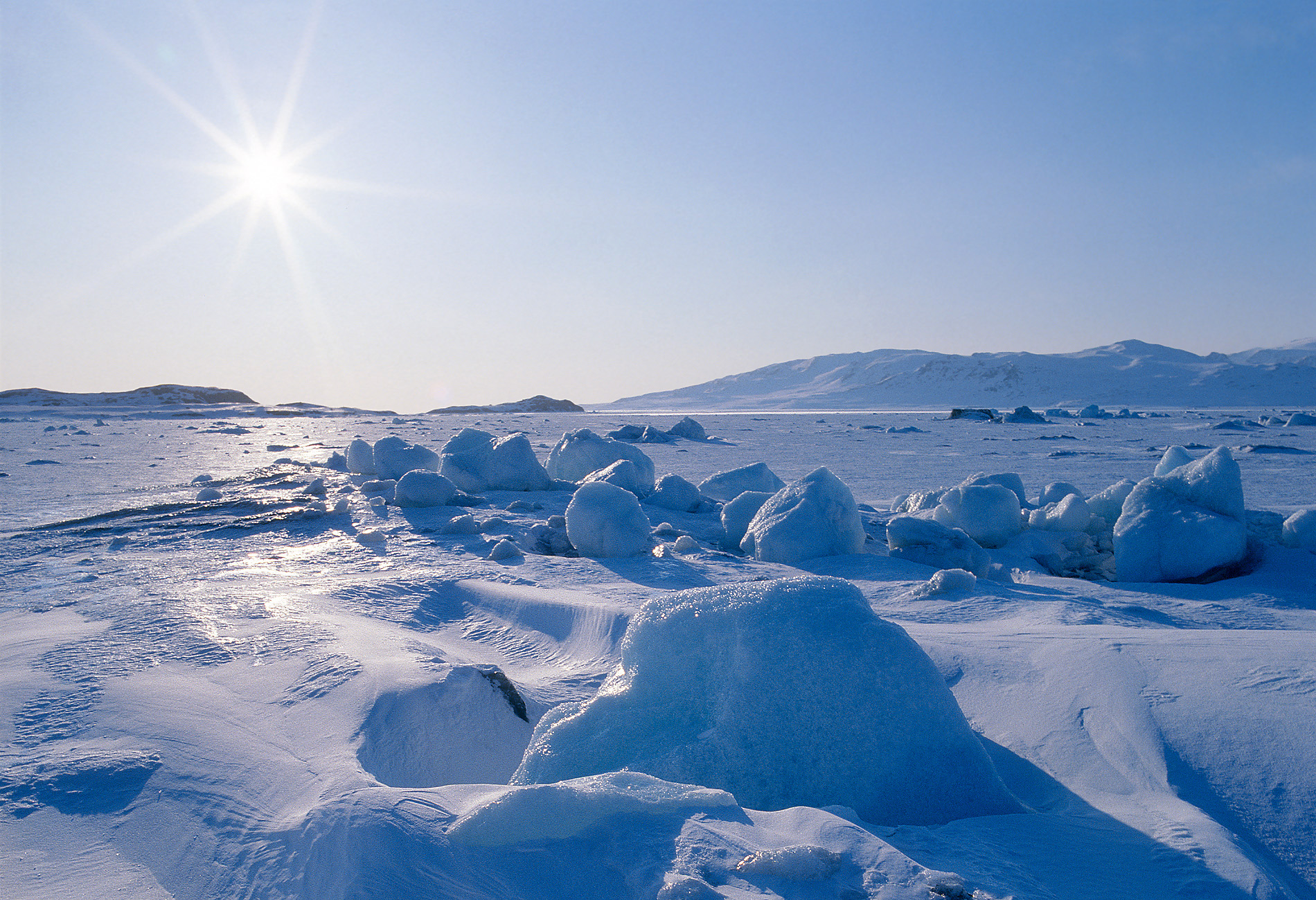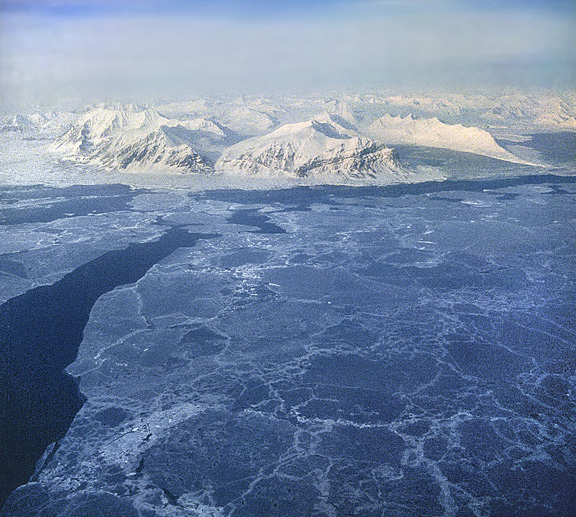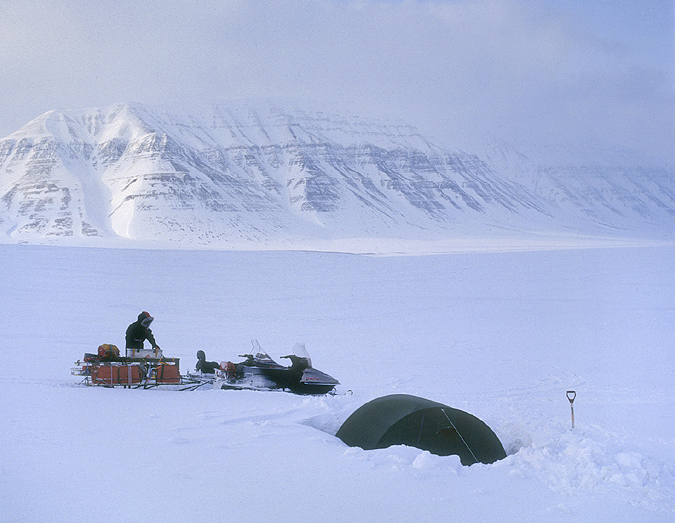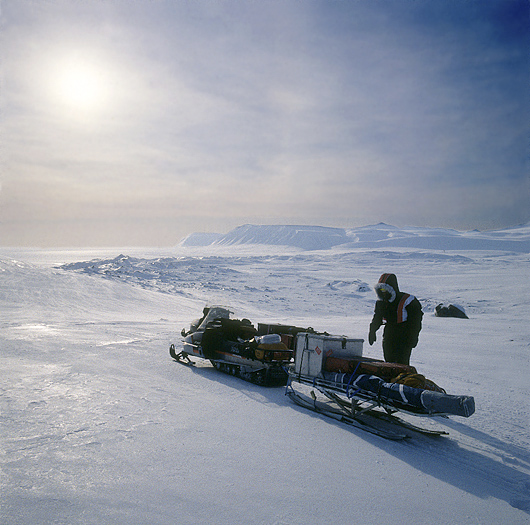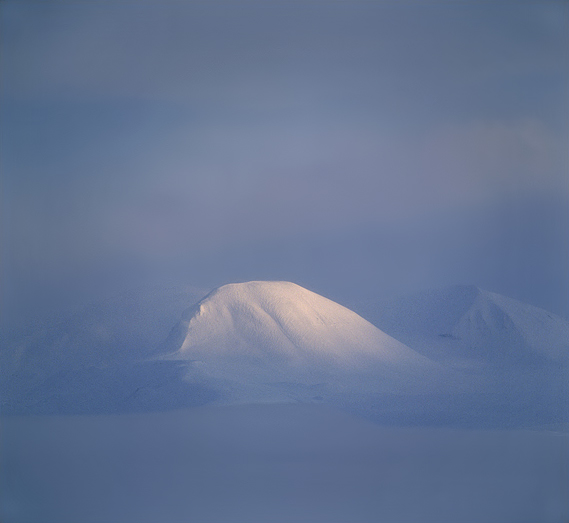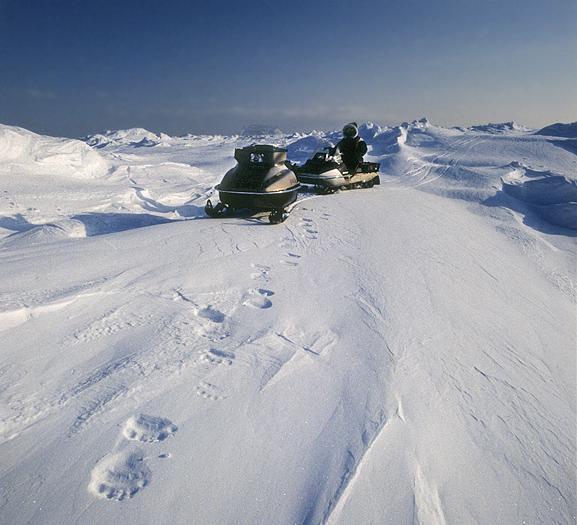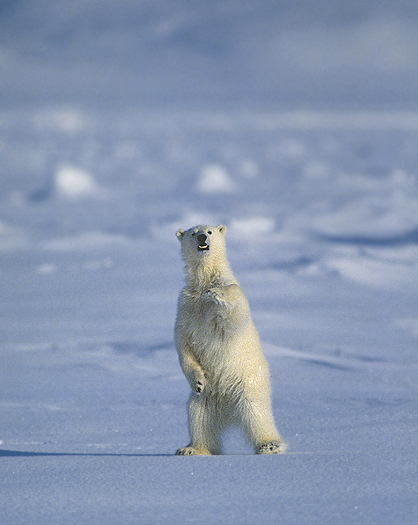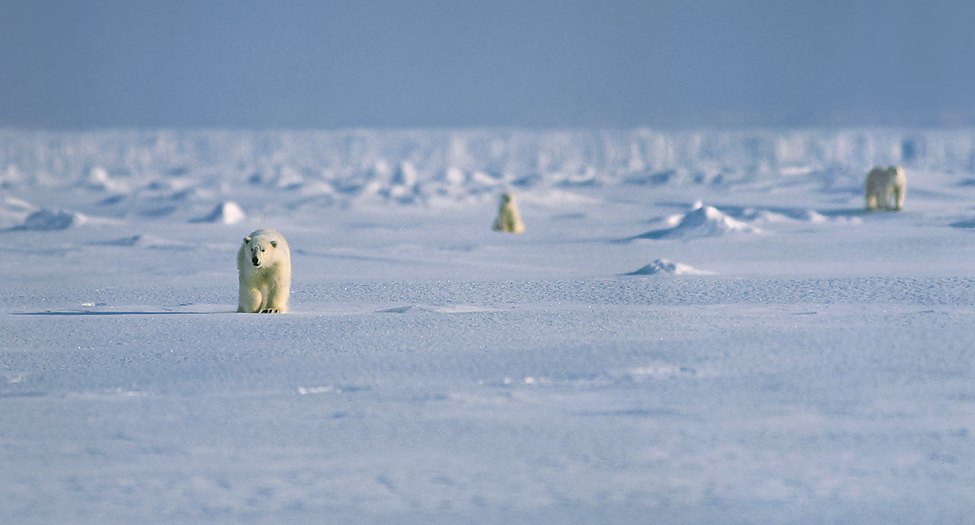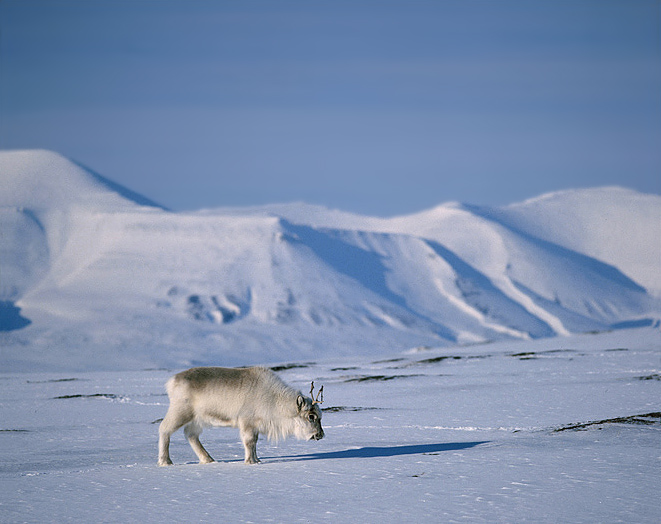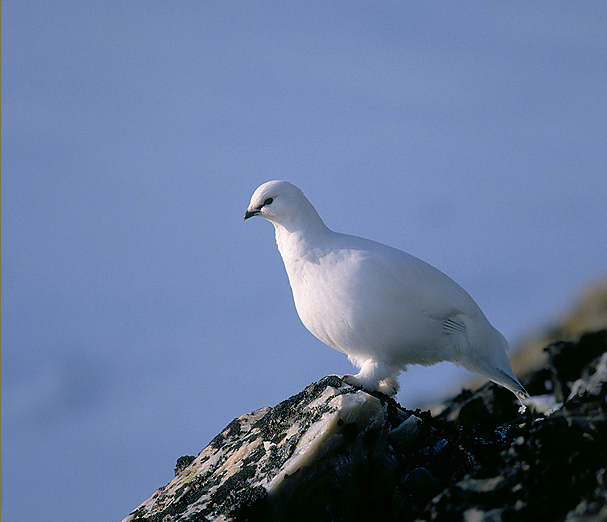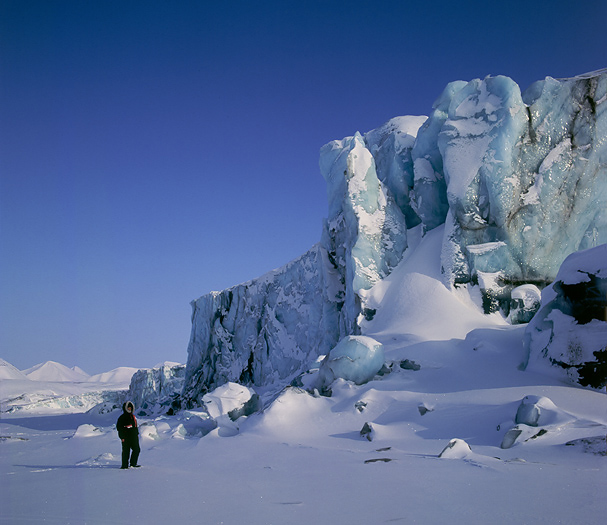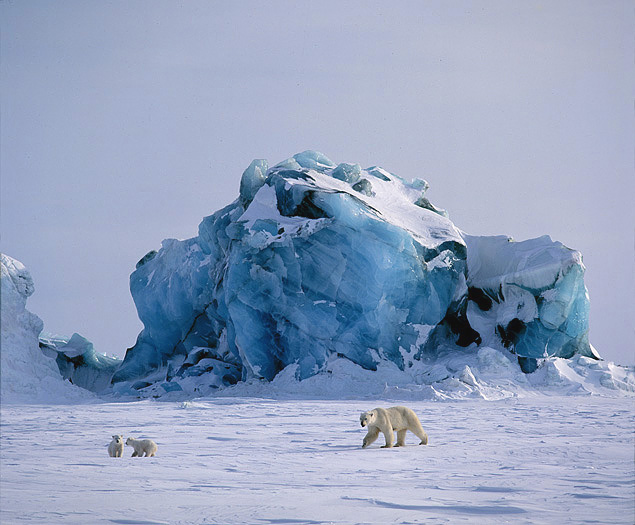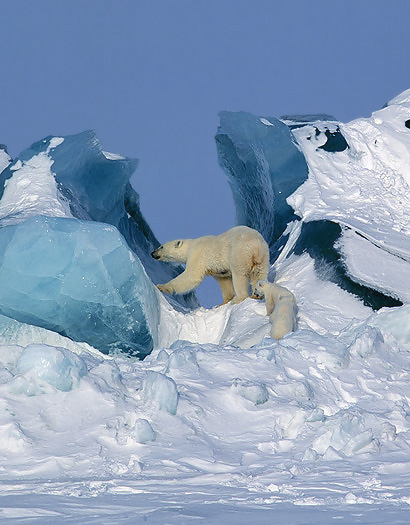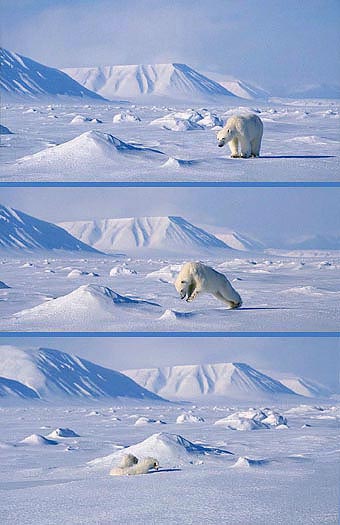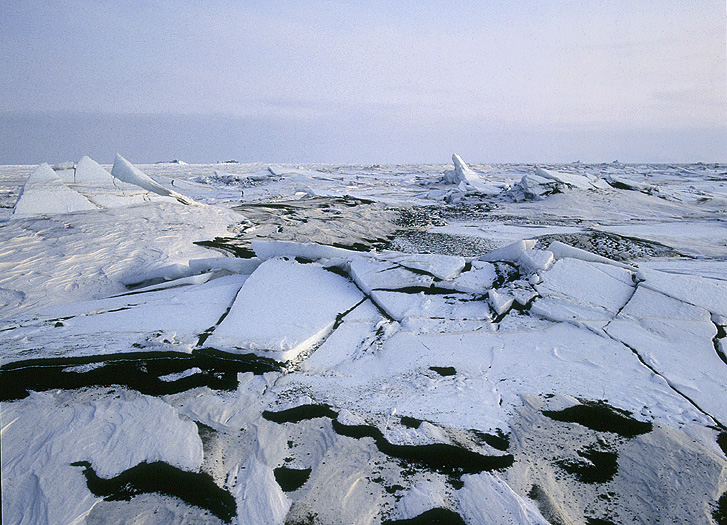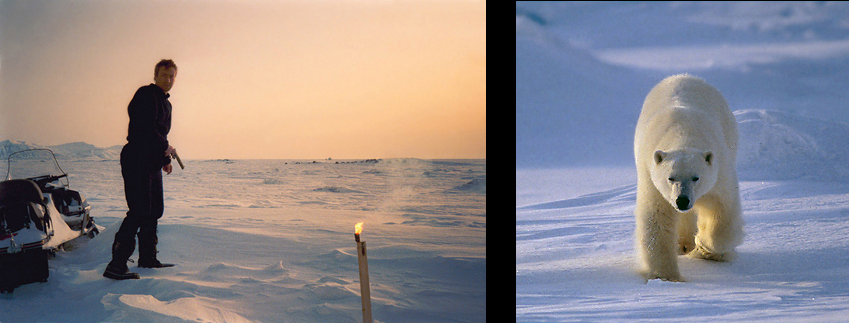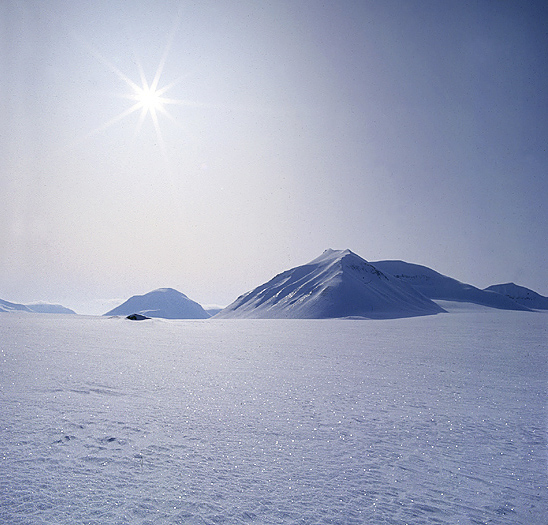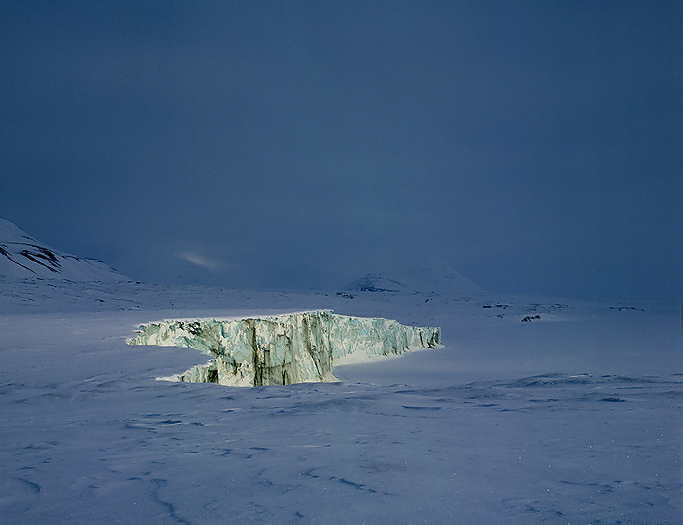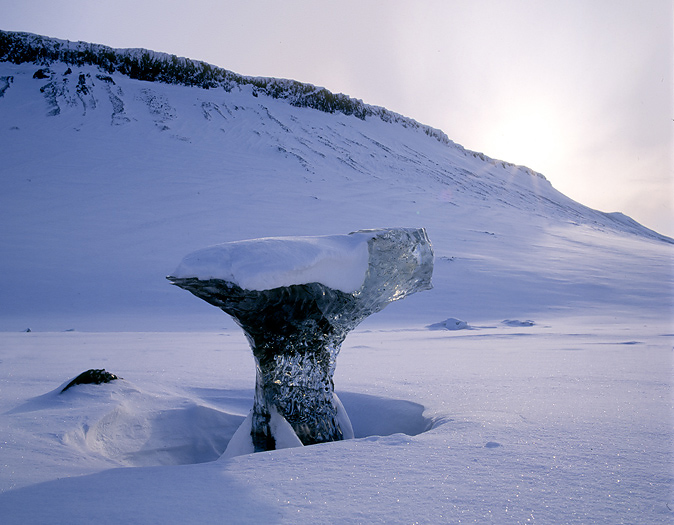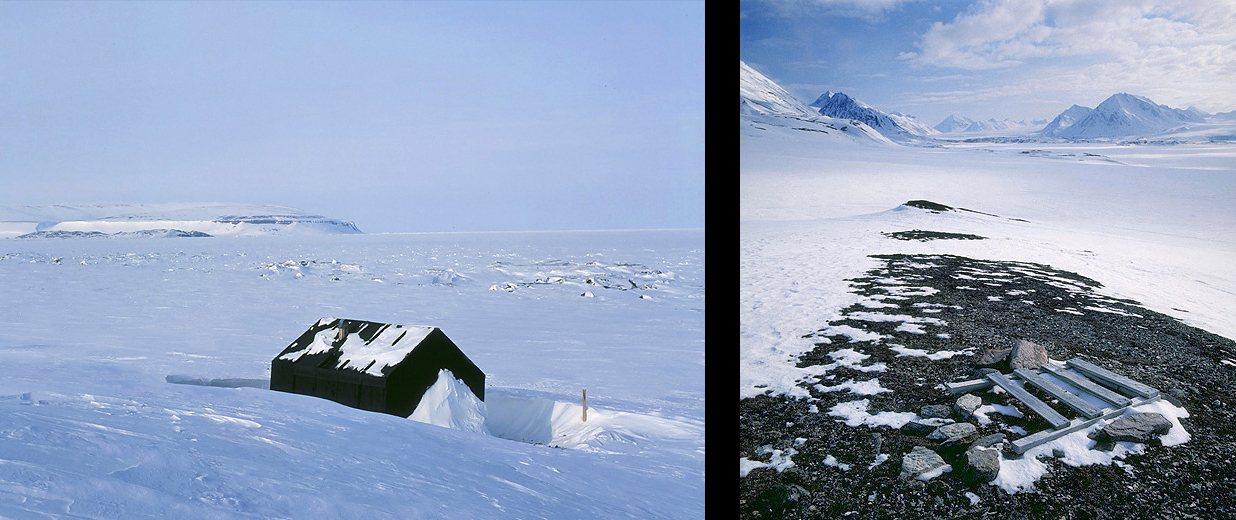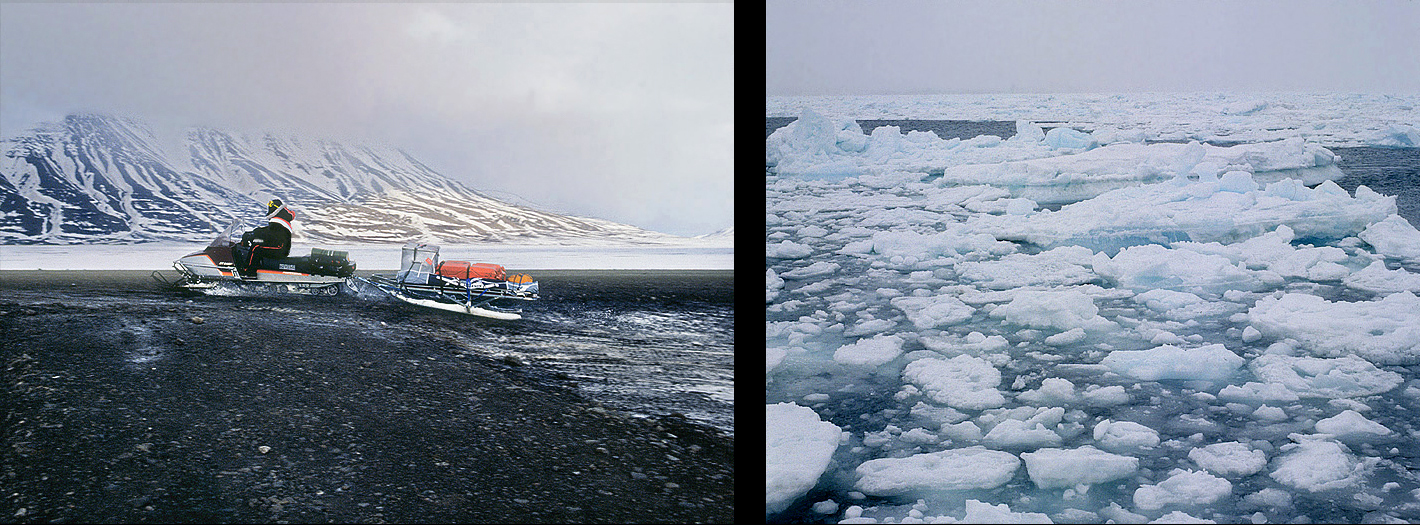A story about a trip to east-Spitsbergen, Svalbard
Svalbard
Northwards again. The date is April 2nd, and the plane has just departed from Stavanger, Norway. It is a short year since I last time was on Svalbard. This high arctic archipelago was officially discovered by the dutchman Willem Barents in 1596, but was most probable visited by the Vikings half a thousand years earlier. Due to the warm Gulf Stream is Svalbard blessed with not having so extremely low temperatures as other arctic areas at the same latitude. Coldest month (February) shows averagely -16ºC on Svalbard, compared to -35ºC at the same latitude in high arctic Canada. Warmest month (July) shows 5ºC on Svalbard versus 7ºC in high arctic Canada. These higher winter temperatures on Svalbard causes less/thinner sea ice with earlier start on summer, which again gives the marine life a longer growth period. Svalbard have of the above reason a very rich & diversed wildlife. Together with a mixed geology with alpine peaks, eroded sedimentary platou mountains and a varied lowland, this archipelago is a real beauty.
Ahead
After a short stop in Tromsø we are in the air again. The flight time should be app. 1½ hours over the Barents Sea. Half the distance to Svalbard we see the first drift ice. Close to Spitsbergen (the main island on Svalbard) there is solid winterice at the east side, and close drift ice in the west. All fjords are absolutely frozen. After a while we arrive the airport at Longyearbyen (78ºN) which is the “Capitol” of Svalbard. Even if this is the “mild arctic” we really feel the -28ºC when leaving the plane. -I nearly forgot how it is to practice tent life under these conditions…
Aerial photo over the mouth of Isfjorden on the west coast of Spitsbergen. We see the mountain Alkhornet in behind.
The next day we set out in the white wilderness, we are two persons (no guide). We are heading eastwards where our intention is to experience & document the yearly Polar Bear migration at the east coast of Spitsbergen. Our snow machines are of the long-belted models as we have heavy loads to drag on the sledges. Total 16 jerrycans (each 20 ltr) of petrol and 1 jerrycan of kerosene for cooking, including food and other equipment make the sledges really heavy. Too heavy should it prove, because one of them broke down only 20km away after we started. We had to return to Longyearbyen and replace them with special built steel sledges instead of the standard aluminum ones. We have to minimize the chances of technical breakdowns when we are far away from the civilization.
After approximately 100km of driving we are forced to stop due to fog and bad weather. We tried to travel further, but had to return a bit because we need at least some visibility and contrast in the snow covered landscape to drive through the passes and cross the glacier that stretches over the valley in the mountainous area. We set up our tent and hope the weather will improve tomorrow.
Next day the weather improved, we broke the camp and moved further east.
We were lucky, because the weather got much better the next day, and we could cross the mountains. On the afternoon the next day we stopped our snow machines on a hill side and looked ahead of us. There we could see the wide Agardh plain end in the frozen fjord at the east coast.
We arrived the east coast of Spitsbergen on a cold and beautiful day.
East Coast
The only wildlife we have seen now for two days was 4 dwarf reindeer in the beginning of our trip. And what did we see here when arriving the east coast ? -Yes, fresh tracks of Polar Bear. In fact so fresh that we had to look around us and check that no Polar Bears was at close distance from us. From now on and for the rest of our stay in the area we have to scan and check the landscape for Polar Bears when resting, eating or walking around. They could be everywhere and to any time. We later experienced that many times. The Polar Bear is the worlds most dangerous animal, and the only one that can believe to have humans on their menu. Well, for the coming weeks it will be us that mainly seek the Polar Bears, and not the opposite, so we ought not to be too afraid of them.
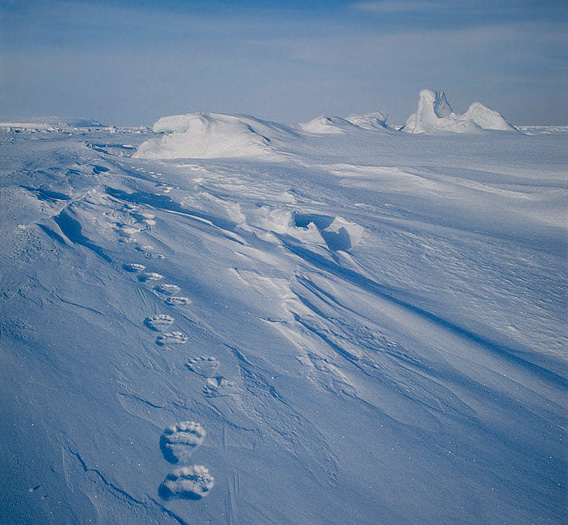
The first sign of life here at the east coast was fresh Polar Bear Tracks.
It is soon evening again, and we find the place for our base camp at Kapp Dufferin. The snow is very deep and powder like here so we cannot stop the snow machines before we have driven in a circle for so to stop in our own tracks,- if not we would have had difficulties when starting up driving again. The place is only 100m from the sea shore, -well by the “ice shore” as the sea is solid frozen. To ensure that we do not get unexpected visitors when sleeping we set up an arrangement of tripwire with flares around the camp. If any Polar Bear should want to go inside the wire and search were the good food smell come from he would have to front the wire and the flare would trigger. To be honest, I went into the wire and triggered the flare more frequently that the Polar Bears ever did.
Midnight by camp near Inglefieldbukta.
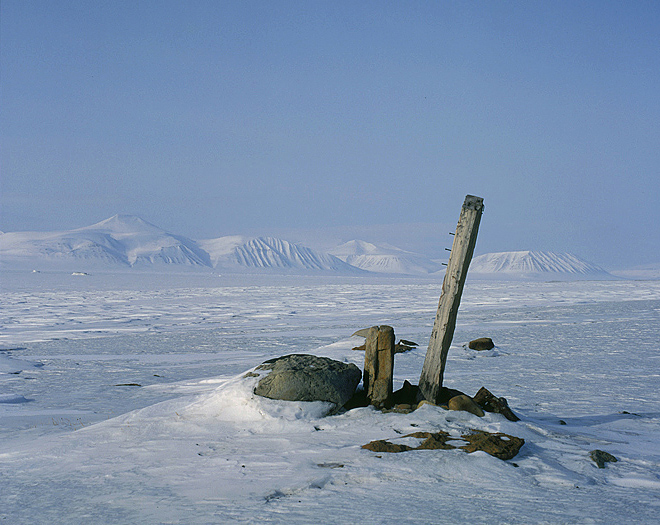
Old trappers grave at the remote east coast of Spitsbergen.
April 6th. A sunny morning, -23ºC. Hopefully the low pressure we had the last couple of days have ended and there will be a period of good weather. After breakfast with coffee, juice and frozen bread that we had to thaw on the frying pan we can set out and explore this wast white wilderness. But before we do so I make myself a nice sitting place in the snow, rest, think over where we really are and look out over this beautiful high arctic landscape. Not a sound, total quietness, -oh how lucky I am to be here. This is certainly something else than a package tour to Mallorca`s beaches. After 2 hours of meditation included scanning the landscape for Polar Bears we set out on the sea ice. Much snow have blown away and is not so deep out here, so it is much easier to drive here than on land. We first started seeing tracks after several Polar Bears out there, for later on that day to see the first Polar Bear on the trip, -what a wonderful animal. 3 Polar Bears we see that afternoon, they were all loners and walked out there from south to north, for now and then to stop and smell both down for seals, and in the air (smelling other Polar Bears? -or perhaps us?).
Fresh Polar Bear tracks out in the pack ice.
Hi there ! What do you want ?
The following days we are out on the sea ice, in valleys near by and up in the mountains. We see more Polar Bears, pure white Arctic Foxes, Dwarf Reindeer and Ptarmigans. Good weather was typical those days. The landscape here is fantastic, it is like a dream, a big white dream with the feeling of unreality. I think that I will have no chance to recover this special feeling about the winter landscape here when I am back home in town again.
Curious Polar Bears on the sea ice of Storfjorden.
Dwarf Reindeer.
Svalbard Ptarmigan.
April 12th. We decide to travel far north today. Olav V Land inhabits one of Svalbard`s biggest glaciers, or may be it is more correct to name it inland ice. The southern part of this inland ice is called Negribreen, its huge glacier front ends direct into the sea. But now in winter nothing moves, and it is not dangerous to go under the huge ice walls. The most common animal to see here is in fact Polar Bears, we see close to 10 bears that day. Sitting on my snow machine I once had 5 Polar Bears around me, one of them came so close as a short meter from me and was near to smell on my stretched out hand. Yes, I know it was very stupid, but extremely tempting, -so tempting that I had to do it. Well, my pulse was of course higher than natural, and I was ready to speed up my snow machine in a fraction of a second. Normally it is easy to see if a Polar Bear is aggressive or wants to scare someone away. Some of the signs are blowing in their nose, and clacking with the teeth. If there are enough prey for them (seals), as here, and they are not extremely hungry, and they do not feel pressed up in any “corner” and need to defend themselves, – near all of them are only curious, especially the young Polar Bears. But it is the aggressive & hungry one that harm or kill a human, and the problem is that they do not tell what their intention is when closing up to a person.
All glacier movements have stopped in the winter time, and it is no danger of walking under the ice walls.
Polar Bear female with 2 small cubs playing on the sea ice.
It is normal for Polar Bears to check out obstacles in their surroundings, -as this iceberg frozen into the sea ice.
Seal hunting.
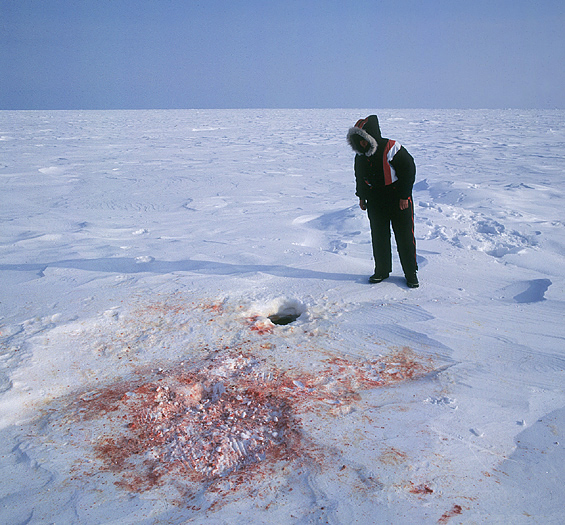
Fresh blood show that a Polar Bear recently have killed a Ringed Seal on the snow covered sea ice.
On our return southwards again we had to pass areas were a storm earlier today had blown near all snow away from the sea ice (see image above WITH snow on the sea ice).
At that day we see that the sky looks a bit darker in the south were we came from this morning. This we get an answer on when returning to our camp in the evening. A local storm have blown all snow away from the sea ice, and it is very difficult for us to drive on solid ice with ice floes that earlier froze together in total disorder. Even further south we have to drive close to land (Agardhpynten) due to that the polynia (area with open water year around) have increased enormously and is now stretching close to land. Late that evening we were very happy to park our snow machines at our base camp. It was a long day full of experiences. After a dinner with meat balls and rice, my eyes closed automatically….
Visitor
April 20st. At four o`clock that night I woke up by footsteps outside. Well, it is only my friend that is out for a leak I thought and laid down again. 2 minutes later: Walking again, -why all this walking ? I turn around for seeing my companion sleeping. Shit,- a polar bear have managed to get inside our trip wire. Quick thinking: “If the Polar Bear gets inside, the situation is doomed to end fatal”, so therefore I rapidly get my 357M revolver an step outside. 2-3 meters away a Polar Bear rise up and stand on his hind legs. Big, really big he suddenly became. I had to look up to see him in his eyes. I tried to scare him away by shooting in the air,- BANG: He did not take any notice of the terrible noise. I shot in the snow between his legs before firing 2 shots in the air again. Then he went down on four legs again before he triggered the flare by the trip wire when walking away!. Slowly he went down to the sea ice and disappeared out there. All the adrenaline pumped into my blood ended my sleep that night. We call it night, but as we know the latitude is so high (78ºN) that it does not get dark at all. Luck that it was not dark when this episode happened. From April 24th the sun shine 24 hours a day, and we can be in activity whenever we would like.
A short minute after the Polar Bear finally left our camp at four o`clock in the morning.
April 22nd. After over 2 weeks here in Polar Bear land we break up for driving southwards into the mountains. Under a deep blue sky we drives miles and miles over the inland ice,- passing numerous of nunataks. Here and there we stop the noisy machines and breath in this clean , cold and sharp air. Not a sound to hear and absolutely nothing life at all to see. Only us two human beings have found their way here. Later that same day we reach the Kvalvågen area.
Nunataks on the inland ice.
We continue even further south and reach Van Keulenfjorden. Here we leave the land of the Polar Bear and see that the Dwarf Reindeer are the most common mammal. Also this fiord is ice covered and we can reach high speed when driving. On some capes we find old wooden traps meant for Arctic Fox hunt. Three old & uninhabited trappers stations still exist in the area, but it is only possible to stay in one of them. The two others are filled with snow. The “Modern Fur Trapping” began in the beginning of the 19th century with less than 100 hunters all over Svalbard, for to increase and make a peak to about 250 before the World War 2. After a near total stop during the WW2 the hunt started again in 1945. When the Polar Bear hunt later was regulated and finally was stopped by law in 1973, the Fur Trapping as a profession was near to be over. Today (2005), there are 3 active Fur Trappers left on Svalbard. This area, in Van Keulenfjorden was good, because there where excellent trapping of both Arctic Fox (especially) and Polar Bear. Price example of trapped fur: The peak year of 1924 the trappers got paid 800,- NOK (US$115) for a single Arctic Fox hide (blue phase). That was a small fortune those days. No wonder why the Fur Trappers in some years was “Kings of the Town” back home on the Norwegian mainland when they had returned from the High North. But unfortunately, for many trappers the money disappeared faster than they was earned, and they were forced back to Svalbard for trapping again on the coming autumn. The Fur Trappers struggled against ice, Polar Bears, dark & loneliness up here. Many of them lost their lives, and in some places their graves are open caused by the permafrost, and the bones are exposed.
The Trappers Station in Duner bukta. Old Arctic Fox traps are still to find.
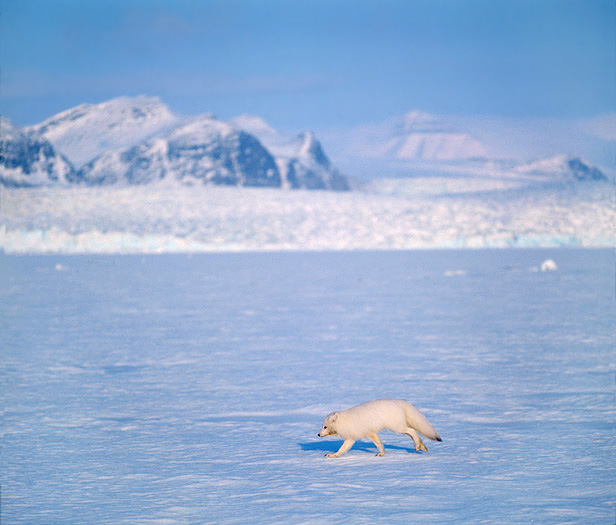
Arctic Fox in winter fur.
Returning
April 28th. We both know that we soon have to meet the civilization again. After 3 exciting weeks in this vast wilderness we set the direction northwest wards for returning to Longyearbyen. We cross the fjords, drive up the wide Reindalen valley, cross through mountainous areas before finally end out in Adventdalen. Here we become very surprised when discovering that great parts of the snow is gone, melted away. The snow machine belts have rolled on much better ground than gravel, but we have to force the machines over the areas of bare land. Reaching the fjord here at the west coast we also see that the fiord have opened up and the black water appears between all ice floes. Closing in to Longyearbyen the snow here and there not are so pure white as we have been used to. All as usual when knowing that the town is based on coal mining.
After a looong hot shower I am sure that I am the cleanest person in town.
It felt very luxurious sleeping in a bed again, but is was also hot to sleep here. My body has now been used to sub zero temperatures both night and days, and it was a bit difficult to regulate back again to normal temperatures again. The thermometer show 18 degrees and I have to sleep with wide open windows. Early next morning I heard the Arctic Fox barked many times outside, also the high arctic Little Auks (Dovekies) were characteristicly cackling in great numbers up at the hill side. Then I knew that the Spring had come and it really was on time to park the snow machines for the season.
Arriving Longyearbyen again we were met by Spring with snow melting and open fjord ice in Adventfjorden.
Afterwords
Since we performed this trip new regulations have come. It is now prohibited to drive in the areas where we have been. Only Svalbard residents are allowed to travel in parts of this land, and only on special routes. We were lucky to be there in time…
Per Michelsen

